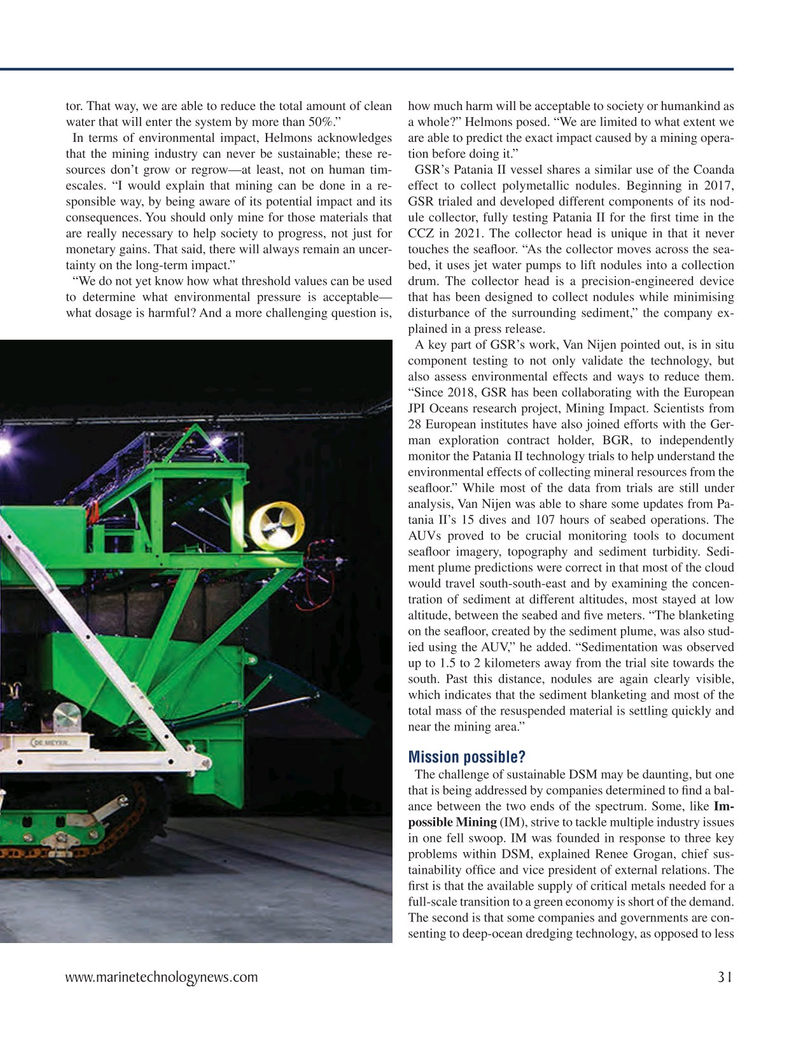
Page 31: of Marine Technology Magazine (September 2022)
Read this page in Pdf, Flash or Html5 edition of September 2022 Marine Technology Magazine
tor. That way, we are able to reduce the total amount of clean how much harm will be acceptable to society or humankind as water that will enter the system by more than 50%.” a whole?” Helmons posed. “We are limited to what extent we
In terms of environmental impact, Helmons acknowledges are able to predict the exact impact caused by a mining opera- that the mining industry can never be sustainable; these re- tion before doing it.” sources don’t grow or regrow—at least, not on human tim- GSR’s Patania II vessel shares a similar use of the Coanda escales. “I would explain that mining can be done in a re- effect to collect polymetallic nodules. Beginning in 2017, sponsible way, by being aware of its potential impact and its GSR trialed and developed different components of its nod- consequences. You should only mine for those materials that ule collector, fully testing Patania II for the ? rst time in the are really necessary to help society to progress, not just for CCZ in 2021. The collector head is unique in that it never monetary gains. That said, there will always remain an uncer- touches the sea? oor. “As the collector moves across the sea- tainty on the long-term impact.” bed, it uses jet water pumps to lift nodules into a collection “We do not yet know how what threshold values can be used drum. The collector head is a precision-engineered device to determine what environmental pressure is acceptable— that has been designed to collect nodules while minimising what dosage is harmful? And a more challenging question is, disturbance of the surrounding sediment,” the company ex- plained in a press release.
A key part of GSR’s work, Van Nijen pointed out, is in situ component testing to not only validate the technology, but also assess environmental effects and ways to reduce them. “Since 2018, GSR has been collaborating with the European
JPI Oceans research project, Mining Impact. Scientists from 28 European institutes have also joined efforts with the Ger- man exploration contract holder, BGR, to independently monitor the Patania II technology trials to help understand the environmental effects of collecting mineral resources from the sea? oor.” While most of the data from trials are still under analysis, Van Nijen was able to share some updates from Pa- tania II’s 15 dives and 107 hours of seabed operations. The
AUVs proved to be crucial monitoring tools to document sea? oor imagery, topography and sediment turbidity. Sedi- ment plume predictions were correct in that most of the cloud would travel south-south-east and by examining the concen- tration of sediment at different altitudes, most stayed at low altitude, between the seabed and ? ve meters. “The blanketing on the sea? oor, created by the sediment plume, was also stud- ied using the AUV,” he added. “Sedimentation was observed up to 1.5 to 2 kilometers away from the trial site towards the south. Past this distance, nodules are again clearly visible, which indicates that the sediment blanketing and most of the total mass of the resuspended material is settling quickly and near the mining area.”
Mission possible?
The challenge of sustainable DSM may be daunting, but one that is being addressed by companies determined to ? nd a bal- ance between the two ends of the spectrum. Some, like Im- possible Mining (IM), strive to tackle multiple industry issues in one fell swoop. IM was founded in response to three key problems within DSM, explained Renee Grogan, chief sus- tainability of? ce and vice president of external relations. The ? rst is that the available supply of critical metals needed for a full-scale transition to a green economy is short of the demand.
The second is that some companies and governments are con- senting to deep-ocean dredging technology, as opposed to less www.marinetechnologynews.com 31
MTR #7 (18-33).indd 31 10/3/2022 8:17:23 AM

 30
30

 32
32
